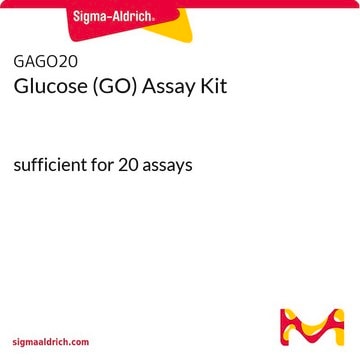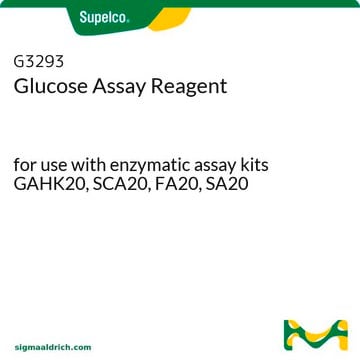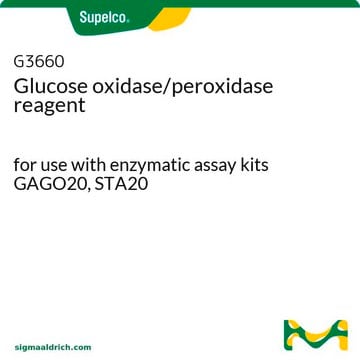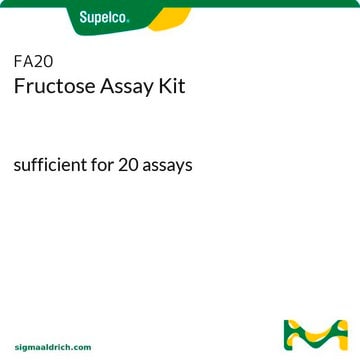Products may be shipped at a different temperature than the recommended long-term storage temperature. If the product quality is sensitive to short-term exposure to conditions other than the recommended long-term storage, it will be shipped on wet or dry-ice. If the product quality is NOT affected by short-term exposure to conditions other than the recommended long-term storage, it will be shipped at ambient temperature. As shipping routes are configured for minimum transit times, shipping at ambient temperature helps control shipping costs for our customers. For more information, please refer to the Storage and Transport Conditions document: https://www.sigmaaldrich.com/deepweb/assets/sigmaaldrich/marketing/global/documents/316/622/storage-transport-conditions-mk.pdf
おすすめの製品
アプリケーション
キットの構成要素のみ
- glucose (HK) assay reagent 20 mL
- glucose standard .5 mL
保管分類コード
10 - Combustible liquids
適用法令
試験研究用途を考慮した関連法令を主に挙げております。化学物質以外については、一部の情報のみ提供しています。 製品を安全かつ合法的に使用することは、使用者の義務です。最新情報により修正される場合があります。WEBの反映には時間を要することがあるため、適宜SDSをご参照ください。
毒物及び劇物取締法
キットコンポーネントの情報を参照してください
PRTR
キットコンポーネントの情報を参照してください
消防法
キットコンポーネントの情報を参照してください
労働安全衛生法名称等を表示すべき危険物及び有害物
キットコンポーネントの情報を参照してください
労働安全衛生法名称等を通知すべき危険物及び有害物
キットコンポーネントの情報を参照してください
カルタヘナ法
キットコンポーネントの情報を参照してください
Jan Code
キットコンポーネントの情報を参照してください
最新バージョンのいずれかを選択してください:
試験成績書(COA)
-
How is shipping temperature determined? And how is it related to the product storage temperature?
1 回答-
役に立ちましたか?
-
-
How can I determine the shelf life / expiration / retest date of this product?
1 回答-
If this product has an expiration or retest date, it will be shown on the Certificate of Analysis (COA, CofA). If there is no retest or expiration date listed on the product's COA, we do not have suitable stability data to determine a shelf life. For these products, the only date on the COA will be the release date; a retest, expiration, or use-by-date will not be displayed.
For all products, we recommend handling per defined conditions as printed in our product literature and website product descriptions. We recommend that products should be routinely inspected by customers to ensure they perform as expected.
For products without retest or expiration dates, our standard warranty of 1 year from the date of shipment is applicable.
For more information, please refer to the Product Dating Information document: https://www.sigmaaldrich.com/deepweb/assets/sigmaaldrich/marketing/global/documents/449/386/product-dating-information-mk.pdf役に立ちましたか?
-
-
The procedure says that solutions that are strongly colored should be decolorized for the kit to work. Do you have any suggestions on how to decolorize my sample?
1 回答-
Solutions may be decolorized by adding a small amount of charcoal, stirring a few moments, and then clarifying by filtration or centrifugation to remove the charcoal. An activated charcoal product, such as item 161551 would be appropriate. See the link below to review this product:
https://www.sigmaaldrich.com/product/sigald/161551役に立ちましたか?
-
-
I want to detect the change of glucose concentration in macrophages. How to prepare the sample
1 回答-
A macrophage sample should be lysed using a cell lysis protocol similar to one used for Western Blotting. A useful lysis protocol can be found linked below.
Following cell lysis, the sample should be diluted with deionized water to 0.05 to 5 mg of glucose per mL. The sample should be deproteinized (using a common perchloric acid precipitation procedure) and filtered to clarify the solution. Any solutions that are strongly colored should be decolorized using a decolorization agent such as activated charcoal. Any samples in which gases are liberated during the sample preparation process should be degassed prior to analysis.
役に立ちましたか?
-
-
How to adapt the Glucose Assay Kit to a 96-well plate?
1 回答-
It may be possible to adapt this kit for use in a 96-well plate format. This would require method development and reagent scale down by the end user. There are no specific instructions available. Should a 96-well assay be preferred or required, please see product MAK476 at the link below. This product has been optimized for use in this format.
https://www.sigmaaldrich.com/product/sigma/mak476役に立ちましたか?
-
-
Is the product G3293-20ML included in the GAHK20-1KT kit?
1 回答-
Yes, the item G3293-20ML is a component of the complete GAHK20-1KT kit. Therefore, if G3293-20ML is on backorder, it can be obtained by ordering the GAHK20-1KT.
役に立ちましたか?
-
-
Is GAHK20 assay compatible with C. elegans worm lysates? What buffer you recommed to prepare lysates?
1 回答-
The Glucose (HK) Assay Kit has been optimized for use in food and other crude materials. This kit has not been qualified for use with cells or organisms such as C. elegans. The researcher would have to determine suitability, however there is some indication that other customers have been successful. See the link below for a publication that may be of interest:
https://journals.plos.org/plosgenetics/article/file?id=10.1371/journal.pgen.1005561&type=printableNote that samples may require centrifugation, filtration or deproteinization to further clarify.
役に立ちましたか?
-
-
Can the procedure for Glucose (HK) Assay Kit, Product GAHK20, be scaled down?
1 回答-
Although we have not done it, you should be able to scale down the procedure as long as you have pipettes capable of dispensing accurate ul volume quantities and an instrument that can monitor the 340 nm wavelength.
役に立ちましたか?
-
-
How do I determine what sample size to use in the Glucose (HK) Assay Kit, Product GAHK20?
1 回答-
If you know approximately how much glucose is present, dilute the sample down to 0.5 to 50 ug of glucose and use between 10 to 200 ul sample volume. If you do not know how much glucose is present, you should assay the undiluted sample and dilutions of it. Based on the dilution factor you can determine the glucose concentration.
役に立ちましたか?
-
-
How do I decolorize a solution for use with Product GAHK20, Glucose (HK) Assay Kit?
1 回答-
You can decolorize a solution by adding a small amount of charcoal to the solution, swirl, then filter or centrifuge to remove charcoal.
役に立ちましたか?
-
アクティブなフィルタ
ライフサイエンス、有機合成、材料科学、クロマトグラフィー、分析など、あらゆる分野の研究に経験のあるメンバーがおります。.
製品に関するお問い合わせはこちら(テクニカルサービス)






